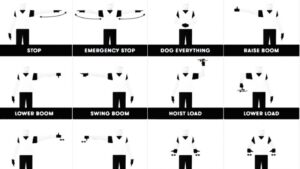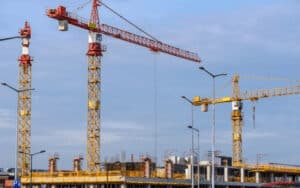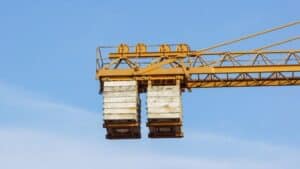
Wind ranks as the second leading cause of crane-related accidents globally.
American National Standards Institute (ANSI) documented 1,125 tower crane accidents worldwide between 2000 and 2010, resulting in over 780 fatalities, 23% of these incidents were attributed to wind exposure—a risk often underestimated in crane operations.
Wind conditions pose significant hazards to crane safety, demanding rigorous monitoring before and during operations. To understand its impact, let’s explore the fundamentals of wind dynamics.
Wind, the movement of air from high- to low-pressure zones driven by atmospheric variations, intensifies with both height and pressure. Measured at 33 feet (≈10 meters) above ground, wind speed escalates at higher elevations, exerting greater force on structures like cranes.
However, an even more insidious threat lies in wind gusts—sudden, unpredictable surges of high-speed airflow within prevailing winds or storms. Unlike steady winds, gusts strike abruptly, often with force far exceeding baseline wind speeds. Their fleeting duration (seconds to minutes) belies their destructive potential, as operators rarely anticipate such rapid shifts. This unpredictability makes gusts a critical, often overlooked risk factor, sometimes surpassing the dangers of sustained winds themselves.
A crane wind speed limit is the highest wind speed at which a crane can be used safely. It depends on the crane’s type, load, and design.
For most cranes, wind speeds above 28 mph (45 km/h) are considered unsafe for most lifting work. Even light objects can become unsafe in strong winds.
Key factors that affect wind speed limits include:
- Type of crane (such as mobile, tower, or crawler)
- Shape and weight of the load
- Weather conditions
Industry Guidelines for Safe Operation
OSHA does not list a fixed wind speed limit. Instead, it says that crane operations must stop if wind causes a hazard: Operations involving personnel transport must undergo immediate safety evaluation by certified professionals when sustained winds or gusts surpass 20 mph (32 km/h) at working height. This assessment determines whether to abort scheduled lifts or halt active operations if hazardous conditions develop.
British safety regulators joint technical guidelines specify that tower crane operations in the UK should observe these wind limitations:
- Cease standard operations at sustained wind velocities reaching 38 mph (16.5 m/s or 60 km/h)
- Implement full operational suspension when wind forces exceed 45 mph (20 m/s or 72 km/h)
Your crane manufactures may have its own limits, and they share wind speed limits in the manuals.
Types of Cranes and Their Wind Speed Limits
Different types of cranes handle wind in their own ways. The design, height, and how you use each crane can change what is considered safe during windy conditions.
Here are some common guidelines:
| Crane Type | Common Wind Speed Limit |
| General cranes | 20 mph (32 km/h) |
| Steel erecting | 28 mph (45 km/h) |
| Tower cranes | 38 mph (60 km/h) |
Tower Crane Wind Resistance

Tower cranes are usually the tallest cranes on construction sites. Because of their height, they are more affected by wind.
Most tower cranes have a maximum wind speed limit between 35 and 45 mph. When wind gets close to this limit, you should stop lifting and move the crane’s jib to a safe, weather-vane position.
Some tower cranes may have lower limits if they are extra tall or have large jibs.
Key points for tower crane safety:
- Stop work if wind is above the limit.
- Park the crane safely.
- Use a reliable anemometer on-site.
Mobile Cranes in Windy Conditions
Mobile cranes have much lower wind speed limits than tower cranes. Most mobile cranes should stop lifting at wind speeds around 20 to 30 mph.
The limit can change based on boom length and the weight or shape of the load. A longer or higher boom catches more wind, so you should reduce the wind limit for those lifts.
Always retract and lower the boom if wind increases past the safe limit. This keeps the crane stable and prevents tipping.
Checklist for mobile crane safety in wind:
- Lower the boom and secure the crane during strong winds.
- Watch forecast and real-time wind speeds.
Gantry Cranes and Other Varieties
Gantry cranes run on tracks and are used in shipyards and factories. They still face wind risks, but their wind limits differ.
Heavy-duty gantry cranes have sturdy frames and can sometimes operate in winds up to 30 mph. Smaller or lighter gantry cranes often have lower limits and should stop at about 20 mph.
You must secure gantry cranes during storms by locking wheels and tying down moving parts.
Gantry crane tips:
- Lock wheels when not in use.
- Lower the beam or arm if high winds are expected.
Site-Specific Risks and Mitigation Tactics
Checklist:
- Use proper fall protection
- Secure all materials and tools
- Monitor wind with reliable equipment
- Stop work if gusts exceed safe levels
Scaffolding and Aerial Lifts Adjacent to Cranes
Scaffolding and aerial lifts near cranes need extra steps for safety. Wind can make these structures less stable, especially if cranes are moving loads overhead.
Inspect scaffolds and lifts for loose connections before each shift. Double-check that guardrails are strong and all anchors are tight.
Never try to move a lift or scaffold when wind speed is higher than manufacturer suggestions, as tipping is possible. Keep scaffolds clear of loose debris.
If you use tarp or netting, remove it during windy weather to stop it from acting like a sail.
Pre-Use Safety Steps:
- Confirm all bolts and ties are tight.
- Check manufacturer wind speed limits for lifts.
- Remove covers or screens that could catch the wind.
- Stay alert for overhead loads.
Adjusting Lifting Capacity for Wind Speeds

When wind speeds rise, you must lower your crane’s lifting capacity to stay safe. Wind creates extra side pressure, which is called wind resistance.
This wind resistance can push against the crane and the load, making lifting riskier.
These charts show how much you can safely lift as the wind goes up.
For example:
| Wind Speed (mph) | Max Lifting Capacity (%) |
| 0-10 | 100 |
| 11-20 | 75 |
| 21+ | Do Not Lift |
As wind speeds get close to 20 mph, you should usually reduce the weight you are lifting. Some cranes have to stop lifting if winds go above 20 mph.
If you use a longer boom or lift a load with a large surface area, the effects of wind are stronger. In these cases, you may need to cut the lifting capacity even more.
Pay special attention to gusts. Even short bursts of higher wind can create big problems when lifting.
Force Of Wind for Given Velocities
*Source: ACCIDENT PREVENTION MANUAL FOR INDUSTRIAL OPERATIONS,
8th Edition, National Safety Council, p. 43
| FORCE OF WIND FOR GIVEN VELOCITIES | ||||
| Miles per hour (V) | Feet per minute | Feet per second | Force in pounds per square foot (0.004V2) | Description |
| 1 | 88 | 1.47 | 0.004 | Hardly perc. |
| 2 3 | 176 264 | 2.93 4.40 | 0.014 0.036 | Just perc. |
| 4 5 | 352 440 | 5.87 7.33 | 0.064 0.1 | Gentle breeze |
| 10 15 | 880 1,320 | 14.67 22.0 | 0.4 0.9 | Pleasant breeze |
| 20 25 | 1,760 2,200 | 26.6 29.3 | 1.6 2.5 | Brisk gale |
| 30 35 | 2,640 3,080 | 44.0 51.3 | 3.6 4.9 | High wind |
| 40 45 | 3,520 3,960 | 58.6 66.0 | 6.4 8.1 | Very high wind |
| 50 | 4,400 | 73.3 | 10.0 | Storm |
| 60 70 | 5,280 6,160 | 88.0 102.7 | 14.4 19.6 | Great storm |
| 80 100 | 7,040 8,800 | 117.3 146.6 | 25.6 40.0 | Hurricane |
Frequently Asked Questions
How do tower crane wind speed limits differ from mobile cranes?
Tower cranes usually have higher wind speed limits than mobile cranes. Many tower cranes can operate safely up to 38 mph, but lifting should stop and the crane should be put into a safe mode if winds go above that.
How do crawler cranes’ wind speed restrictions compare to those of other cranes?
Crawler cranes have wind speed limits similar to mobile cranes.
You should usually halt lifting operations around 20 to 25 mph winds unless the manufacturer’s instructions say otherwise.
Always check the crane manual for specific guidance.
What are the safety practices for crane operators?
Crane operators need special safety training to handle high wind risks which teaches how to read wind speed gauges, check weather reports, and understand when to pause work.
They should know how to inspect and care for all your gear. Practice using fall arrest systems so that you are ready if something goes wrong.






